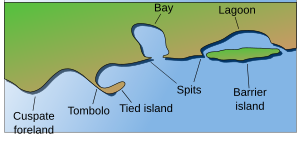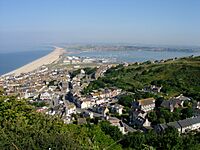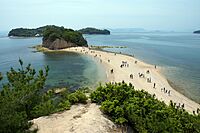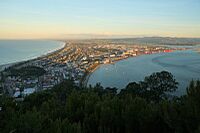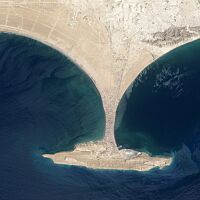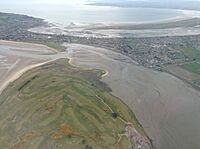Tombolo facts for kids

A tombolo is a sandy or shingle isthmus. Imagine an island that gets connected to the mainland by a narrow strip of sand or pebbles. That strip of land is called a tombolo! It's a special type of landform created when sand and other sediments (tiny bits of rock and dirt) are deposited by the ocean. Think of it like a natural bridge made of beach material.
Once an island is connected by a tombolo, it's often called a tied island. The word tombolo comes from the Italian word tombolo, which means 'pillow' or 'cushion'.
Sometimes, you might see several islands connected together by these sandy strips, forming what's called a tombolo cluster. If two or more tombolos connect, they can even create an enclosed area of water called a lagoon, which might eventually fill up with more sand over time.
Contents
How Do Tombolos Form?
Tombolos form because of how ocean waves and currents interact with islands. When waves hit an island, they slow down and bend around it. This change in wave movement causes sand and other sediments to build up in the calmer water behind the island. Over a long time, enough sediment can pile up to create a sandy bridge connecting the island to the mainland.
Waves and Sediment: The Main Ingredients
The main way true tombolos are formed is through something called wave refraction and diffraction. Don't worry, it's simpler than it sounds!
- Wave Refraction: As ocean waves get close to an island, the water gets shallower. This makes the waves slow down and bend, almost like light bending when it goes through water.
- Wave Diffraction: Waves also spread out after passing an obstacle, like an island.
These two actions cause the waves to bend around the island and meet on the opposite side. When the waves meet, they lose energy, and the sand and pebbles they were carrying drop to the seafloor. This process is called deposition. Over many years, this deposited sand builds up, forming a sandy ridge (like a mini-beach) that grows longer and longer until it finally connects the island to the mainland. It's like the waves are sweeping sediment together from both sides of the island!
Sometimes, Longshore Drift Does the Job
While wave refraction and diffraction are key for "true" tombolos, sometimes a tombolo-like feature can form mainly due to longshore drift. Longshore drift is when waves hit the coast at an angle, pushing sand along the shoreline in one direction.
For example, places like Chesil Beach in England, which connects to the Isle of Portland, or the sandy strip connecting Cádiz in Spain, are often called tombolos. However, the sand ridge in these cases runs parallel to the coast, and the main force building them is the continuous movement of sand along the shore, not just waves bending around the island. So, while they connect an island to the mainland, they are also very similar to a spit, which is a ridge of sand extending from the coast into the water.
What Makes Tombolos Special?
Tombolos are very sensitive to changes in the environment. Even a small island or a sunken ship can change how waves move, which then affects where sand gets deposited. Things like sea level rise can also play a role, as rising water might push more material onto the shore, helping a tombolo grow.
Because they are made of loose sand and pebbles, tombolos can change shape and size quite a bit due to tides, storms, and strong winds. They are often less stable than a regular beach. To make them more stable, especially if roads or buildings are put on them, people sometimes build structures to protect them.
If you look closely at a tombolo, you might notice that the sand and pebbles are coarser (bigger) near the bottom and finer (smaller) near the surface. This is because strong waves can wash away the finer grains at the top, revealing the larger stones underneath.
Cool Examples of Tombolos Around the World
Tombolos are found all over the world! Here are some famous and interesting examples:
- Aupōuri Peninsula, New Zealand
- Barrenjoey Headland, Pittwater, New South Wales, Australia
- Burgh Island, Devon, England
- Cádiz, Andalucía, Spain
- Chesil Beach, Portland, Dorset, England
- Cheung Chau, Hong Kong
- Crimea, Ukraine
- Eaglehawk Neck, Tasmania, Australia
- The Rock of Gibraltar
- Gwadar, Pakistan
- Hakodate, Hokkaido, Japan
- Howth Head, Dublin, Republic of Ireland
- Kapıdağ Peninsula, Balıkesir, Turkey
- Llandudno, North Wales
- Miquelon, Saint-Pierre and Miquelon, France
- Monemvasia, Laconia, Peloponnese, Greece
- Monte Argentario, Tuscany, Italy
- Mont-Saint-Michel, Normandy, France
- Mount Maunganui, New Zealand
- Nahant, Massachusetts, United States (a natural tombolo, but connected to the mainland by a causeway)
- Nissi beach, Ayia Napa, Cyprus
- Ormara, Pakistan
- Palisadoes, Kingston, Jamaica
- Peniche, Portugal
- Peniscola, Castellon, Spain
- Presqu'ile de Giens, Hyères, France
- Quiberon, France
- Ras Hafun, Somalia
- Seongsan Ilchulbong in Jeju Province, South Korea
- Sharp Island, Sai Kung District, Hong Kong
- Silver Strand (San Diego), Coronado, California, United States
- St Michael's Mount, Cornwall, England
- St Ninian's Isle, Shetland, Scotland
- Sveti Stefan, near Budva, Montenegro
- Vatersay, Scotland – this island is actually two sections connected by a wide tombolo
- Zhifu Island, Yantai, China
It's worth noting that some of these might be simple isthmuses (narrow strips of land connecting two larger landmasses) and might not have formed exactly by the deposition process that defines a "true" tombolo.
Image gallery
-
The tombolo connecting St Ninian's Isle with the Shetland Mainland in Scotland.
-
Monte Argentario, Tuscany, Italy, showing its tombolos.
-
Chesil Beach, seen from the Isle of Portland looking towards mainland Dorset, England.
-
The Angel Road of Shōdoshima, Japan, which is a tombolo that appears at low tide.
-
Looking south from the summit of Mount Maunganui, New Zealand, to the city of Tauranga.
-
The eastern end of Bennett Island with its glaciated tombolo in the background.
-
An aerial photo of the isthmus of Sutton which connects Howth Head and County Dublin, Ireland.
See also
 In Spanish: Tómbolo para niños
In Spanish: Tómbolo para niños


